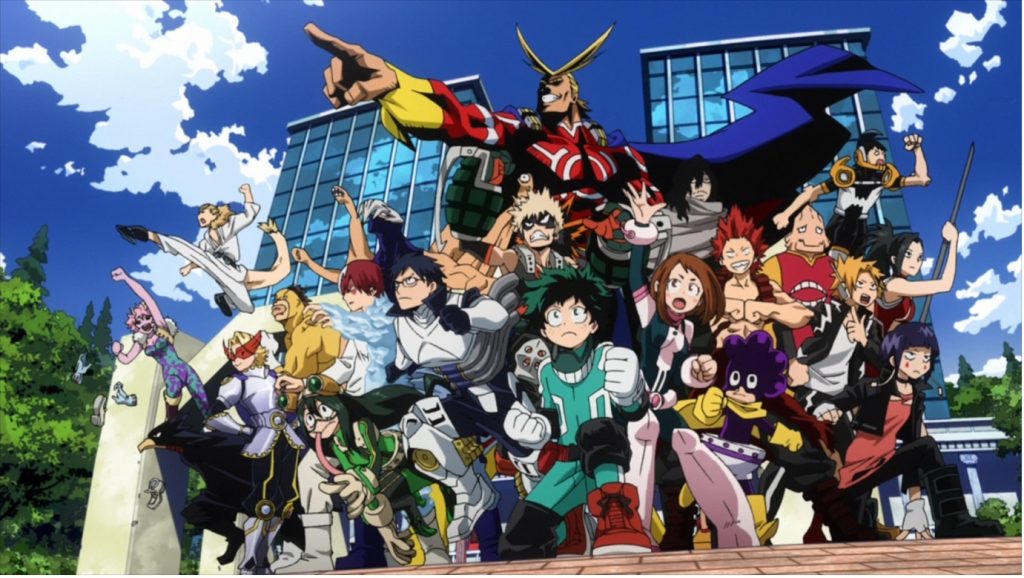Tackling the subject of anime superheroes, both the graduate thesis “Superman vs. Goku: Different Cultural Values Represented in Superhero Characters in American and Japanese Comics”[1] and the widely viewed YouTube video essay How HeroAca and One Punch Man Flip the Script on Superhero Anime share one important point: Japanese superheroes are implicated in more formal institutions and larger social webs than their western counterparts. For the graduate thesis, this means the superheroes are prompted to take action, not in terms of an abstract problem—“aliens are invading the earth”—but always in terms of direct harm to their social circle, which is a prominent element of the show—“those aliens, who happen to be invading the earth, attacked my friend.” For the video essay, the language is more based on the contrast between superman, batman, and ironman as lone operatives and the organization-based approach to Japanese superheroes. Within the video essay’s framing, superhero anime nowadays follow from a Japanese tradition of sūpā sentai and magical girl squads and so feature groups of heroes contained within larger institutions like schools (My Hero Academia, 2016), business corporations (One Punch Man, 2015 and Tiger and Bunny, 2011) or government branches (Fire Force, 2019 and Gatchman Crowds, 2015).

Another commonality between the video essay and the thesis is that they explain this difference through a distinction in national cultures. There is the common object, superheroes, and then its use in two markets, the American-dominated western market and the Japanese market. This explanation is useful, but it leaves something to be desired and its weakness helps highlight an intersection between superheroes and animation.
Putting aside that it was partially under the influence of the British show Thunderbirds (1965) that the sūpā sentai (Power Rangers) model formed,[2] the major point that both works miss is that they are only comparing anime superheroes from live-action western releases. Western children’s animation continues to give a sizeable body of clearly institutionalized, socially implicated, and light-hearted superhero shows. To give just some recent examples, Young Justice (2011), Teen Titans (2003), and Marvel Rising (2018) all have team dynamics under the somewhat watchful eye of the ‘adults’; O.K. KO Let’s Be Heroes (2013) features superhero school, rankings, collectible cards, and a 9-5 job; and Ben 10 (2005) takes on his role as defender of earth only as long as the aliens interrupt his family road trip. All these superheroes are only limitedly motivated by abstract morals, or an ubermensch position beyond society. They instead have outside sources of authority and close non-abstract relationships on which to base their heroism. So then, rather than a sign of differing national cultures, we might think of the so-called “institutionalized” hero as an indicator of a teen/children’s media tradition across national cultures.
This conclusion highlights a pool of animated sources about superheroes whose qualities call attention to them. From this I make two claims that wish to provoke further study. First claim: youth-targeted animations about superheroes will provide unique insight on the strained relationships between superheroes and society. Superheroes are only super against ordinary society. Yet, they are only heroic by that society’s praise, making for a double movement of estrangement and dependence. The child, as not yet a full individual, emphasizes that dependence on the larger social web. Do child-heroes then show a way to be both super and social? How do their institutions compare to the fleeting “assemblages” formed for the climaxes of each marvel movie? How does the liminal stage of the teen come across in their superhero identity? Might structuring institutions ultimately serve to further estrange all heroes from the mass?
Second claim: Children’s superhero animations are commentaries upon childhood institutions. How might missions and authority figures reimagine family authority? How do superhero schools and training re-imagine education? What kind of distinction between work and play do these shows construct? How might the team itself be caught between its role as work and found family? And, as an adult-turn takes place in animation, how is the authority of the institution called into question?
By way of conclusion, I might give my initial answer to one of the questions. As I would frame it, the child hero is too institutionalized. These characters are never forced to take a self-reflective perspective on their relation to the world for which they sacrifice themselves. While this framing might be dismissive, I would favor it because it highlights the critical juncture between institutionalization and detachment that the young adult superhero show delivers upon. In the East, you could point to One Punch Man (2015), which uses a superhero organization to return to the school-like social ties that had been lost on the protagonist’s quest for supremacy. Hence, its hilarious mix of mid-20s malaise and superheroism. Meanwhile in the west, the widely acclaimed series Invincible (2021) or the movie Spiderman into the Spiderverse (2018) are great examples. Each superhero team or parental backing quickly reveals itself to be insufficient in different ways, returning the main character to his own uncertain motivations about being a superhero.
Patrick Gwillim-Thomas is an undergraduate studying Japanese and Korean at the University of Oxford. His interests include animation studies, comic studies, and Japanese media theory and he is currently working on an article for the Mechademia Journal as well as his PhD applications. At the moment, he is interested in live streaming culture online, and in particular in the nature of liveness and the technologies by which it is created in digital spaces.
[1] Matsuura, Daisuke, Brown, Michael R., Millar, Frank, and Young, Suzanne. Superman vs. Goku: Different Cultural Values Represented in Superhero Characters in American and Japanese Comics, ProQuest Dissertations and Theses. Web. 2010.
[2] For a brief summary of the development of Japanese superheroes see Akiko Sugawa-Shimada (2014). “Japanese superhero teams at home and abroad: super-sentai in Japan and their adaptation in South Korean cinema,” Journal of Japanese and Korean Cinema, 6:2, 167-183, DOI: 10.1080/17564905.2014.961713

A very thought provoking post, thanks for writing it!
great content, thanks for sharing